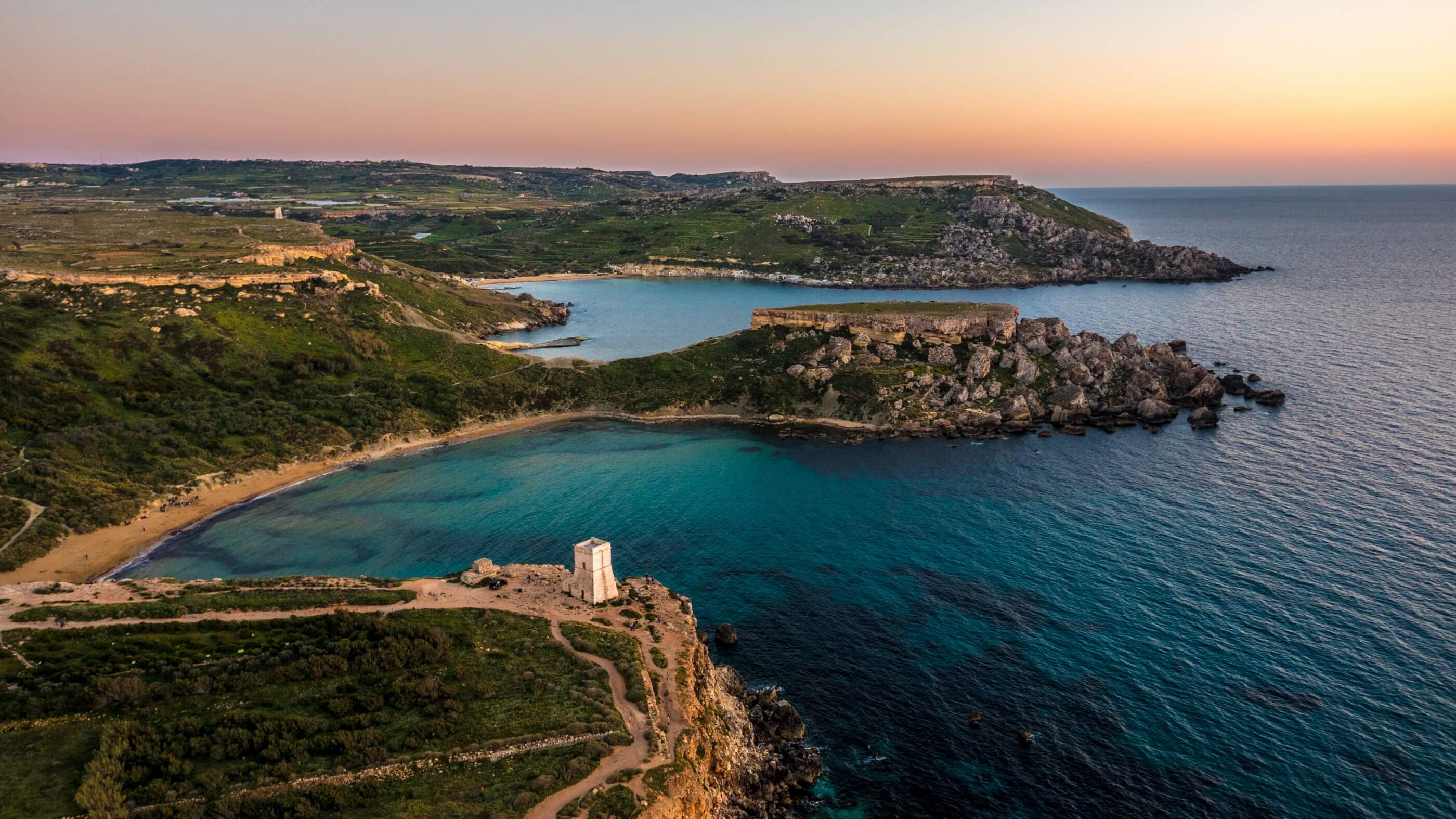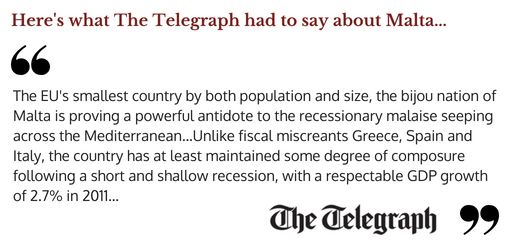Moving to Malta?
Here are some useful facts about Malta…
The Republic of Malta is located in the centre of the Mediterranean, 80km south of Sicily. It covers just under 320 km2 which makes it one of the smallest states in the world. The capital city is Valletta and there are three Islands, namely, Malta, Gozo and the smallest being Comino. Malta is a member of the EU, the United Nations and the Council of Europe.
-
Population
The estimated total population is currently around 437,000 pre-dominantly made up of Maltese (95%) who are descendants of the ancient Carthaginians and Phoenicians and there are also strong Italian and Greek influences. There is also a strong British community (1.6%)
-
Climate & Sea
Malta gets about 300 days of sunshine a year generating an average year-round temperature of 19 degrees. Long hot summers and mild winters are standard. Malta also has an average sea temperature of 22 degrees and has just been voted the ‘Best Diving in the Mediterranean’ and ‘3rd Best Diving in the World’ in a recent poll by International Diver Magazine!! There are also some fantastic sandy beaches scattered all over the Island.

-
Language
Malta has its own unique Semitic language which descends from the now-defunct Sicilian-Arabic dialect of Southern Italy. English is also an official language of Malta with some 88% of Maltese speaking it fluently. Italian is also popular with 66% of Islanders speaking it. Legal documents are always in English so it is very straightforward for Expats to get by.
-
Religion
The majority of the population in Malta are Roman Catholics but there are other religions represented including Islam, the Church of Jesus Christ of Latter Saints, Jewish and Jehovah Witness.
-
Crime
Malta has very low levels of crime which make it one of the safest places to live in Europe.
-
Food
Malta has an abundance of fresh fruit and vegetables due to its fertile soils. Seafood is also very common but it is the fusion of Italian and North African influences that really make Malta an interesting gastronomic destination.
-
Driving
Much like the British the Maltese drive on the left-hand side of the road. Indeed many of the road signs and markings are very similar or the same as the British system. EU citizens can drive in Malta using their existing licenses or apply for a Maltese license after residing in the country for 6 months or more.
If you are moving to Malta permanently you can import your car and bring it with you without paying Registration Tax as long as you have owned the car for 2 years or more (download the VEH07 from Malta Transport Authority website). This exemption is limited to one car per person relocating. Otherwise, there is a Registration Tax to pay which can get expensive. Details can be found at the Malta Transport Authority.
-
Public Transport
Malta has just invested in a large fleet of new air-conditioned buses which operate extensive networks throughout the Islands. There are also frequent ferry services connecting Malta to Gozo and Sicily.
-
Communication
There are 2 main mobile phone service providers on the Island (Go and Vodafone) both providing good coverage. These companies also supply Internet packages. TV subscriptions are also available including all the top sports channels from SKY. The national television station of Malta is called TVM and is state-owned. Most of its programs are in Maltese but there are some English broadcasts. There are many radio stations on the Island many of which speak English. There are also two English speaking daily newspapers, The Times of Malta and The Malta Independent.
-
Utilities
The standard electricity supply in Malta is 240 volts with a 3 pin British style plug and is supplied by Enemalta. Bills can be sporadic so it’s common when renting to pay the landlord an estimated amount on a monthly basis which is then adjusted when a bill is received. There is no piped gas supply in Malta but bottled gas is quite common and is a good option.
-
Pets
Malta is a member of the European Pet Travel Scheme that allows pets to enter the country without quarantine restrictions as long as certain criteria and treatments have been made and paperwork provided. These include anti-worming, anti-rabies and various other hygiene checks which are performed before the animal is sent to Malta by the owner’s vet. Pets will also have to have a Pet Passport (or a Pet Travel Scheme Certificate) and be microchipped.
-
Currency
The Euro is the official currency of Malta.
-
Healthcare
Malta has a very high standard of healthcare both private and public. In fact, in 2018 it was voted amongst the ‘top 10 in the world’ by a leading Healthcare authority. Hospitals are well equipped and well funded and there are many regional health centres located all over the Island. The health service is funded through taxes and is free to residents and members of the EU. Foreign nationals will need to have private health insurance in place.
-
Education
Malta has a high standard of English speaking schools which are based on the British system including a well respected University. Education is compulsory for children between the ages of 5 and 16 years. For Expats, there are also two international schools, namely Verdala which is an American based International Baccalaureate Diploma School and St.Edwards which is a Catholic Boys school that follows the British Curriculum.
-
Property
Download our definitive ‘Guide to Renting in Malta’ >> Rental Brochure
Click here for our 5 steps to the Buying and Selling process in Malta
-
Job Opportunities & Business
Malta is fast becoming an extremely cosmopolitan place with many nationalities choosing to reside here due to its favourable tax schemes and because of a large influx of overseas gaming companies who have made Malta its European base. As a result, Malta has been largely sheltered from the economic troubles of the rest of Europe.

-
Family
Malta is a fantastic place to bring up a family due to the low crime rates and general safety for children plus the sheer amount of outdoor activities that can be enjoyed throughout the year due to the warm climate. Family plays an extremely important role in Maltese culture.
-
History
Ever since the Maltese archipelago was first colonized thousands of years ago, they have never been far from the centre of events and have often played a crucial role in the making of history. Their strategic situation in the centre of the Mediterranean Sea makes up for all the lack of resources that nature endowed the rest of the globe. Malta, the largest island, and her sister islands of Gozo, Comino, Filfla, are strategically placed in the narrow channel joining the eastern and the western basins of the Mediterranean, or if you like, a bridge between Southern Europe and North Africa, or between Western Europe and the Middle East. This has landed the Maltese Islands right in the middle of the most important historical events: the wars between Rome and Carthage, the rise of Islam, the Crusades, the wars between Christians and Moslems, the rise and fall of Napoleon, the rise and fall of the British Empire, the fight for democracy against Fascism and Nazism, the Cold War, the rise of a United Europe and the challenges of the Third Millennium.
On 9 April 2003, the European Parliament approved by an overwhelming majority the accession to the EU of 10 new Member States. This opened the door for Malta to become a full member of the Union on the 1st May 2004. From that day on, Malta has officially taken its seat in European institutions and has five fully fledged members in the European Parliament.
-
Tourism
Malta is a popular tourist destination with nearly 2 million visitors a year and is the strongest pillar of the Maltese economy. It is for Malta an economic necessity, the motor that propels the service sector. About half the jobs in the Archipelago are connected directly or indirectly to tourism.
The country boasts of luxury hotels, highly skilled staff, excellent high-tech conference facilities and superb recreational activities as well as many charming villages and unique cultural monuments, from prehistoric temples to the fortifications and rich architecture. The Maltese Islands include many sandy and rocky beaches where one can laze about during the hot summer months.
-
Art
Malta has a strong artistic heritage which began with the residence Knights of St.John who were strong supporters of the arts and left a legacy of masterpieces from their 250-year rule which can be found in various museums, palazzos, and churches on the Island. Renowned artist ‘Carravaggio’ also spent 15 months on the Island and painted at least 7 works, the most notable being ‘The Beheading of Saint John the Baptist’ which can be seen at the Conventual Church of St.John in Valletta. The Baroque movement also had a profound influence on Maltese Art and Architecture especially with the Calabrese artist Mattia Preti who spent his last 40 years on the Island creating some of his finest works (now on display at the Museum of Fine Arts in Valletta). Malta’s various museums have a vast array of treasures that truly reflect the incredible history of this intriguing Island.
Read our Checklist for Moving to Malta to help you make the move!